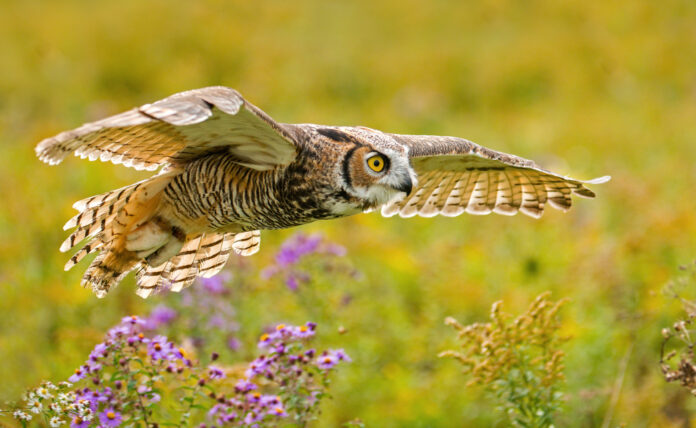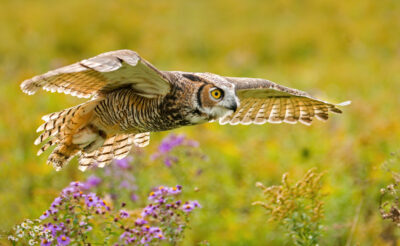
BY HARRY WEEKES

Love is in the air. Actually, it is perched in the naked branches of an aspen tree, 32 feet above me. A male great horned owl is calling. It is a little after 4:30 a.m., there is not a cloud in the sky, and the moon is two days past full—a glowing orb over the bird’s left shoulder.
The call is deep and pure. Across the valley, in a cluster of spruce trees, comes a response—not the resonant “hoo hoooo hoo hoo” of the male above me, but the “other” response, the one of the female. This is written as “guwaay” in my bird book, but sounds just different to me.
Needless to say, I am thinking about owls. I am thinking about these birds, specifically these two birds, who do most everything at night, except sleep. They rely on stealth, on being quiet, on making no noise, simply because doing so would make it a whole lot harder to eat and therefore survive. And along comes a conundrum, the conundrum of all of the living world—reproduction. How does the owl solve the problem of finding and attracting a mate, at night, when they want to be as quiet as possible?
Elaborate calls and flashy songs are a non-starter, as are the colorful plumages of their diurnal cousins. About the last things you want to do at night are be really loud and glowing. And the first thing you want to do at a certain time is find a mate.
For about 50 million years or so, nocturnal owls have been solving this problem. That solution, the distillation, is the call I am hearing.
This call is deep. It is resonant. It is rich. It travels easily over at least two square miles, and it is evocative. What is it saying to something completely and utterly attuned to it? I imagine it conveys everything important—size, age, health, ability to survive and thrive in this environment, knowledge and understanding of the local area, strength, agility, and vigor.
It is the bugle of an elk. The antlers of a moose. The howl of a wolf. It is the story of a life, and the fingerprint of an individual.
If I am this bird, it is the story of who I am—a vocal autobiography compressed into a series of notes that undulate across the snow and permeate the woods.
This story is filled with a richness I can easily disregard because of its simplicity. If this were some showy songbird, all yellow and orange, creating a ruckus, I would believe more complex things about bird communication and intelligence. But a couple of “hoo hoos” in the dark of night are easy to overlook, which is why I like the unfolding of a walk and the time to ruminate on such things.
If I had to distill my life into a song, could I do it? If I had to distill everything into five to seven notes, what would I say? Now, let’s pretend I was able to pull this this off. This is still but half of the equation, as the most important biological question of all is still unanswered- “Would anyone respond?”
Harry Weekes is the founder and head of school at The Sage School in Hailey. This is his 48th year in the Wood River Valley, where he lives with Hilary and two of their three baby adults—Penelope and Simon. The other member of the flock, Georgia, is currently fledging at Davidson College in North Carolina.
